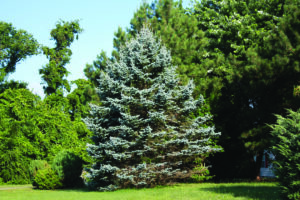Choosing the perfect Christmas tree is often a family event that takes place at a local farm market, a tree nursery or a box store.
There are always choices — a tall tree, a short tree, a thin tree or a fat tree.
For some, a cut tree is the best choice because, if well-watered, the cut tree can last indoors for a few weeks. 
A live tree needs a bit more planning before picking out the tree.
Look over the yard to determine where to plant the tree that will allow it room to grow both upwards and outwards.
Once the spot has been chosen, place a covering of 2-3 inches of mulch over the area where the tree will be planted before the soil freezes, the mulch will keep the soil warm enough when it will be time to plant the tree.
Choosing the type of tree can be difficult because most of the trees that are loved for Christmas trees are used to colder climates.
The beloved Fraser fir is a native eastern tree that lives very happily in the Appalachian Mountains.
It can grow 30-50 feet tall and 20-30 feet wide and it likes to grow in moist, well drained soil.
The Fraser fir is able to live in our zone 7 but care will need to be taken to keep it well watered during the heat and droughts of our Eastern Shore summers.
The Norway spruce is not native but grows as well as the Fraser fir in our area.
It also likes to grow in moist but well drained soils but can grow 40-60 feet tall and 25-30 feet wide.
Another choice could be the smaller version of the White spruce, the Dwarf Alberta Spruce, which grows only 15-25 feet tall and seven to 10 feet wide.
The Dwarf Alberta Spruce can grow in warmer temperatures than either the Fraser or Norway spruce, but will still need to be well watered during the heat of summer.
These dwarf trees can be grown in containers and are often found on either side of a front entry,, butcare must be taken to plant them several feet away from a building where excessive heat can build up.
Almost all of the other wonderful Christmas tree choices need to live in much cooler areas in the summer and thrive in much colder areas in the winter, and should only be considered for a cut tree.
A live Christmas tree needs to be prepared to come indoors by being moved into an unheated garage or shed, or on a sheltered porch with the root ball or root container placed inside a larger waterproof container.
Keeping it the unheated or sheltered area will allow the plant to warm up marginally and be out of the drying winds.
On Christmas day the tree can be brought indoors with the root ball still inside the large waterproof container and be placed on display and decorated.
The best spot is any place that is away from heat vents or fireplaces, and the tree can stay indoors for only a few hours.
Once the tree is undecorated and moved outdoors, it should go back into the unheated garage or the sheltered porch for at least a few days, so the tree can become re-adjusted to the outdoor cold temperatures.
Move the mulch away from the area where the tree needs to be planted, and dig a hole that will accommodate the root ball or soil inside of the container but will allow the soil to be about 1 inch above the soil line.
Make the hole two times wider than deep, and mix some compost into the soil that has been removed.
If the tree is in a container, remove it from the container and with a sharp knife, slice the soil root ball from the top to the bottom on all four sides, going only about a half inch deep.
This will trim the roots and encourage them to grow in other directions than around the inside of the container, and get established into the new soil home.
Place the tree in the hole and add the amended soil around the root ball.
Make a saucer at the outer edge of the hole to catch and hold water.
Spread the mulch around the tree, covering up the bare soil but leaving about 2 inches of space around the tree trunk.
If the tree has been dug and has burlap wrapped around the soil root ball, place the root ball into the hole, making sure the top of the root ball is about 1 inch above the soil line.
Fill the amended soil up three quarters full, then cut the rope away that is wrapped around the tree trunk.
Gently pull the burlap at least 3 inches away from the stem of the tree.
Fill the rest of the hole with the amended soil and create a saucer.
Spread the mulch around the tree to cover the bare soil but leave about 2 inches of space around the tree trunk.
Be prepared to water the tree at least twice a week with two to three gallons of water in the springtime as soon as the maple tree leaves emerge.
Once the heat of summer arrives and the temperatures rise to 85, water the tree at least three times a week with the same amount of water.
The trees will not need extra watering in the winter but will always need at least three to five gallons of water once a week in the summer, especially if the Shore is in a drought.
A live tree that can be planted outside will be a growing reminder of happy memories for years.
(Editor’s Note: Ginny Rosenkranz is a commercial horticulture specialist with the University of Maryland Extension.)



